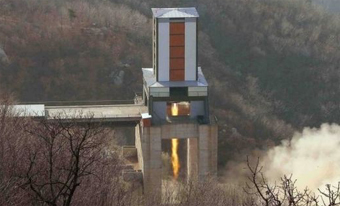
Image from North Korea state media
North Korea Rocket Engine Test May
be Key Step Toward ICBM
| published March 22, 2017 |
By Thursday Review staff writers
A North Korean ballistic missile test early on Wednesday may have resulted in instantaneous failure when the rocket exploded just moments after it lifted off its launch platform at an east coast launch facility near Wonson. Intelligence and Pentagon analysts say that it is unclear why the missile exploded in a ball of fire, but the test comes amidst steadily rising tensions between North and South Korea, and an escalating war of words between the United States and Pyongyang.
The launch and the resulting explosion was detected by military and intelliegnce officials in South Korea, Japan, and by U.S. naval forces working in the area. The missile which exploded was an intermediate-range ballistic missile capable of carrying a small nuclear warhead, though analysts agree the rocket used in Wednesday morning's test was unarmed.
But despite Wednesday's spectacular failure, North Korea may be within six months to one year of having the capability to launch an intercontinental ballistic missile, according to weapons analysts and Pentagon officials who have spoken to U.S. media.
CNN is reporting that a rocket engine tested only days ago in North Korea may be the next-to-the-last step in a long but rapid process begun several years ago by the regime of Kim Jong-un—a program of testing newer rockets and missiles which has included missiles launched from land and sea. Pyongyang has conducted a record number of rocket tests since the start of 2017, including the simultaneous launch of four ballistic missiles into the Sea of Japan earlier in March, and the testing of a long-range ballistic missile in mid-February.
Last Sunday’s test firing of a heavier, more powerful engine—some defense analysts believe—shows that North Korea is moving aggressively toward the capability to place warheads on missiles able to reach other continents, including the west coast of the United States.
Officials in Pyongyang declared Sunday's test a huge success, and described it as “a great leap forward” in North Korea’s openly-stated goal of possessing offensive nuclear weapons.
Sunday's test came only two days after U.S. Secretary of State told reporters that North Korea’s aggressive weapons and rocket program was a threat to the Pacific region, and suggested bluntly that U.S. military intervention was now a consideration.
North Korea has ramped up both its bellicose language and its weapons testing in response to the start of annual joint military exercises between the militaries of the United States and South Korea. The two countries have for decades conducted the joint maneuvers which often include testing the readiness of new weapons, naval and air exercises, communications systems, and joint troop movements on the ground. Pyongyang has long considered such drills as rehearsals for an invasion of the North and a prelude to war.
But over the last three years the young and often unpredictable Kim Jong-un has rapidly stepped up North Korea’s military readiness, and in open defiance of United Nations rules and international sanctions, sought to bring North Korea fully into the small club of nations with both nuclear weapons and the tools to deliver such warheads to its enemies. North Korea has tested several small nuclear devices in recent years, and may be inching closer to the more difficult goal of placing viable warheads atop missiles.
Sunday’s test of the new rocket engine comes after months of test launches of missiles have shown that Kim is seemingly unconcerned with world opinion or U.N. resolutions, and—according to some analysts who have viewed video footage of the test—may have taken North Korea one step closer to its stated goal of being able to strike any country with its missiles and its warheads.
According to Pyongyang media, the weekend test was meant to measure the effectiveness and power of the missile’s propellant and combustion, the reliability of turbines and the structural integrity of the chamber. Cloaked with camouflage and a wall, the rocket engine’s power can be judged by analyzing the video provided by North Korean media. The video seems to show a very large and powerful rocket engine, which analysts now believe may have the capacity to traverse the Pacific Ocean, though it is unclear that North Korea has reached the all-important stage of perfecting a nuclear warhead small enough and light enough to be deployed atop even the largest rockets yet tested by Pyongyang.
Wednesday's failure of a ballistic missile also demonstrates that North Korea's rocket program still has problems, and that Pyongyang has failed to develop entirely reliable missiles for the delivery of warheads. Several missile tests in 2015 and 2016 ended in failure, including a sub-launched missiles which may have exploded while still in the launch tube.
.
Still, the immense strength of last weekend’s test worries many defense and weapons experts, who say the rogue nation may be steadily reaching its goal of having the capacity to strike the U.S. and its allies. Tillerson and other U.S. officials have begun to hint that direct military action might result from any further testing of such weapons. Tillerson was on a diplomatic tour of several Asian countries when this latest test took place.
Related Thursday Review articles:
North Korea Launches Ballistic Missiles; R. Alan Clanton; Thursday Review; March 6, 2017.
North Korea Test Fires Ballistic Missile; R. Alan Clanton; Thursday Review; February 12, 2017.
